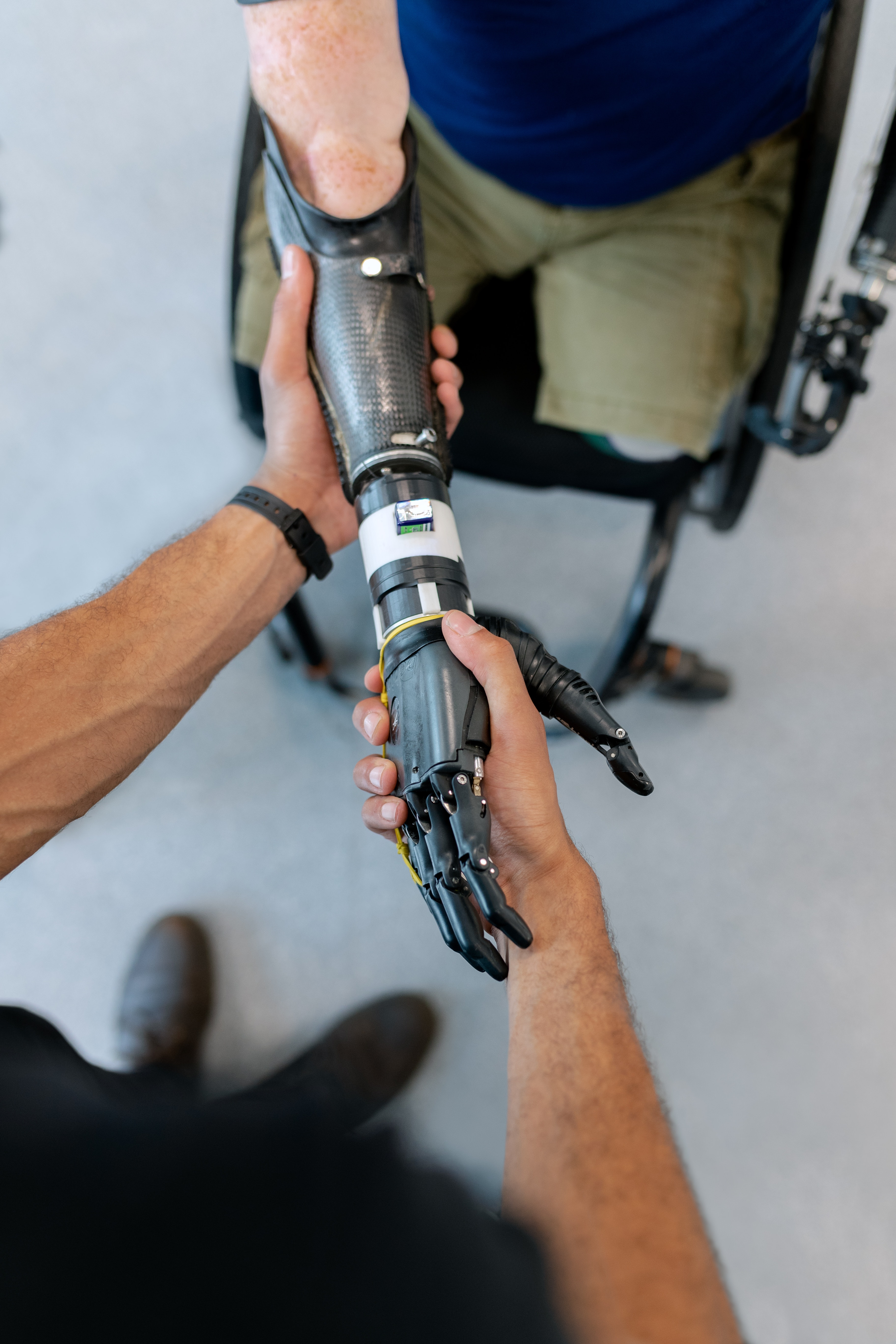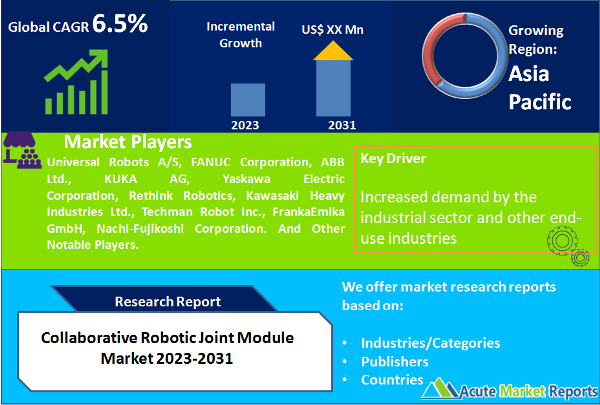
The collaborative robotic joint module market is expected to grow at a CAGR of 6.5% during the forecast period of 2025 to 2033. Increasing demand for collaborative robots (cobots) in various industries such as manufacturing, logistics, and healthcare. Collaborative robotic joint modules are key components of cobots, enabling them to perform complex tasks in collaboration with human workers. The market for collaborative robotic joint modules is driven by several factors, including the growing need for automation and increased focus on workplace safety. Cobots are designed to work safely alongside humans, without the need for physical barriers, which makes them suitable for a wide range of applications. This has led to the adoption of cobots in industries where human-robot collaboration is crucial, such as assembly lines, material handling, and precision tasks. Furthermore, advancements in sensor technology, artificial intelligence, and machine learning have enabled collaborative robotic joint modules to become more sophisticated and capable of performing tasks with high precision and flexibility. This has expanded their applications across various industries, leading to increased market demand. The market for collaborative robotic joint modules is highly competitive, with several key players operating in the market. These companies are constantly investing in research and development to enhance the performance and capabilities of collaborative robotic joint modules, as well as to expand their product portfolios. They are also focusing on strategic partnerships, collaborations, and acquisitions to strengthen their market position and gain a competitive edge.

Increasing Adoption of Cobots in Various Industries
The collaborative robotic joint module market is being driven by the increasing adoption of cobots in various industries, such as manufacturing, logistics, and healthcare. Cobots are designed to work alongside human workers, enhancing productivity and efficiency in various tasks. This adoption is supported by the need for automation to improve operational efficiency and reduce labor costs. For example, in the manufacturing industry, cobots are used for tasks such as assembly, welding, and quality inspection, as they can work alongside human workers to perform repetitive and mundane tasks with precision and speed. In the logistics industry, cobots are used for tasks such as order picking, packing, and palletizing, as they can work collaboratively with human workers to optimize warehouse operations. In the healthcare industry, cobots are used for tasks such as patient care assistance and medication delivery, as they can work safely alongside healthcare professionals to improve patient care.
Advancements in Sensor Technology and Artificial Intelligence
Advancements in sensor technology and artificial intelligence have significantly contributed to the growth of the collaborative robotic joint module market. Sensor technologies such as vision sensors, force/torque sensors, and tactile sensors enable cobots to perceive their environment and interact safely with humans. Artificial intelligence and machine learning algorithms enable cobots to learn and adapt to changing conditions, making them more flexible and capable of complex tasks. For instance, advanced vision sensors enable cobots to accurately identify and locate objects in their environment, allowing them to perform tasks such as object recognition, tracking, and picking. Force/torque sensors enable cobots to detect and respond to external forces, allowing them to safely interact with humans and handle delicate objects. Tactile sensors enable cobots to have a sense of touch, enabling them to perform tasks that require fine motor skills and delicate handling. These advancements in sensor technology and artificial intelligence have expanded the capabilities of collaborative robotic joint modules and increased their adoption in various industries.
Focus on Workplace Safety and Ergonomics
Workplace safety and ergonomics are significant drivers for the collaborative robotic joint module market. Cobots are designed to work safely alongside humans, without the need for physical barriers or cages, which improves workplace safety and reduces the risk of accidents. Cobots are also designed to be ergonomic, considering human factors such as reachability, visibility, and ease of use, which enhances their usability and reduces worker fatigue. For example, cobots are equipped with safety features such as collision detection, speed reduction, and emergency stop buttons, which allow them to work safely near human workers. Cobots are also designed to have compact footprints, lightweight structures, and intuitive user interfaces, which make them easy to integrate into existing workflows and reduce the physical strain on human workers. This workplace safety and ergonomic features have led to increased adoption of collaborative robotic joint modules in industries where human-robot collaboration is critical.
Shell Joint ModulesExpected to be the Most Lucrative Market During the Forecast Period
The type segment of the collaborative robotic joint module market can be further categorized into two types: Shell Joint Modules and Shellless Joint Modules. Among these, Shell Joint Modules are anticipated to exhibit the highest CAGR and generate the highest revenue in the forecast period. Shell joint modules are designed with an outer protective covering, also known as a shell, which provides additional safety features for human-robot collaboration. These joint modules are widely used in collaborative robotic applications where physical interaction with humans is required, such as in cobots used for assembly, packaging, and inspection tasks. The shell provides a protective barrier that prevents any accidental contact between the robot and human workers, ensuring safe and reliable operation in collaborative environments.
APAC to Remain the Most Lucrative Market During the Forecast Period
North America and Europe are expected to dominate the market with a high revenue percentage due to the presence of well-established industries and the early adoption of collaborative robotic joint modules in various applications such as automotive, electronics, and healthcare. Additionally, Asia-Pacific is projected to exhibit the highest CAGR during the forecast period of 2025 to 2033 due to rapid industrialization, growing demand for automation in manufacturing processes, and increasing investments in robotics and automation technologies by emerging economies such as China, Japan, and South Korea. These regions are witnessing a surge in demand for collaborative robotic joint modules to enhance productivity, improve manufacturing processes, and reduce labor costs. Furthermore, the Asia-Pacific region is also experiencing an increased focus on research and development activities in robotics, thereby driving the growth of the collaborative robotic joint module market. In summary, North America and Europe are anticipated to have the highest revenue percentage, while Asia-Pacific is expected to exhibit the highest CAGR during the forecast period in the collaborative robotic joint module market.
Market Competition to Intensify During the Forecast Period
The Collaborative Robotic Joint Module market is witnessing intense competition among key players, with a focus on innovative solutions and strategic partnerships to gain a competitive edge. Some of the top players in the market include Universal Robots A/S, FANUC Corporation, ABB Ltd., KUKA AG, Yaskawa Electric Corporation, Rethink Robotics, Kawasaki Heavy Industries Ltd., Techman Robot Inc., FrankaEmika GmbH, Nachi-Fujikoshi Corporation. And Other Notable Players. These companies are actively engaged in research and development activities to develop advanced collaborative robotic joint modules with improved functionalities, increased payload capacities, and enhanced safety features. Additionally, they are also investing in artificial intelligence (AI), machine learning, and sensor technologies to enable their robotic joint modules to adapt to dynamic environments and interact with humans more intuitively. In terms of strategies, these key players are focusing on partnerships, collaborations, and acquisitions to expand their product portfolios, reach new markets, and strengthen their market position. For instance, many players are collaborating with end-user industries such as automotive, electronics, and healthcare to develop application-specific solutions that cater to the unique requirements of these industries. Additionally, partnerships with research institutions and universities are also common to foster innovation and technological advancements in the collaborative robotic joint module market. The collaborative robotic joint module market is highly competitive with key players focusing on innovative solutions, strategic partnerships, mergers and acquisitions, and geographic expansion to gain a competitive edge. Continuous research and development, along with a strong focus on customer requirements, are driving the growth of the market, and the competitive landscape is expected to remain dynamic as new players enter the market with advanced technologies and solutions.
Historical & Forecast Period
This study report represents analysis of each segment from 2023 to 2033 considering 2024 as the base year. Compounded Annual Growth Rate (CAGR) for each of the respective segments estimated for the forecast period of 2025 to 2033.
The current report comprises of quantitative market estimations for each micro market for every geographical region and qualitative market analysis such as micro and macro environment analysis, market trends, competitive intelligence, segment analysis, porters five force model, top winning strategies, top investment markets, emerging trends and technological analysis, case studies, strategic conclusions and recommendations and other key market insights.
Research Methodology
The complete research study was conducted in three phases, namely: secondary research, primary research, and expert panel review. key data point that enables the estimation of Collaborative Robotic Joint Module market are as follows:
Market forecast was performed through proprietary software that analyzes various qualitative and quantitative factors. Growth rate and CAGR were estimated through intensive secondary and primary research. Data triangulation across various data points provides accuracy across various analyzed market segments in the report. Application of both top down and bottom-up approach for validation of market estimation assures logical, methodical and mathematical consistency of the quantitative data.
| ATTRIBUTE | DETAILS |
|---|---|
| Research Period | 2023-2033 |
| Base Year | 2024 |
| Forecast Period | 2025-2033 |
| Historical Year | 2023 |
| Unit | USD Million |
| Segmentation | |
Type
| |
Application
| |
|
Region Segment (2023-2033; US$ Million)
|
Key questions answered in this report